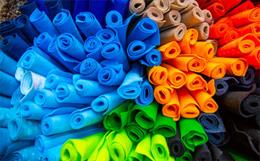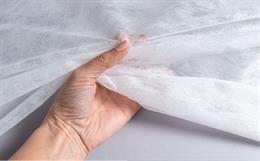DEMANDFOR NONWOVENS IN CENTRAL AND SOUTH AMERICA
In2012, demand for nonwovens in Central and South America reached 515,000 metrictons, representing seven percent of the world total. Despite the large size ofits population, sales of nonwoven fabrics in Central and South America arelimited by the region's relatively low level of economic development,reflecting a scarcity of capital that has hindered industrialization efforts.Brazil is by far the largest market for nonwovens in the region, accounting for56 percent of total demand. Other significant national markets includeArgentina, Chile, Colombia, Peru, and Venezuela. Nonwovens demand in theregion expanded at a 9.3 percent annual rate between 2007 and 2012. Suppliersbenefited from economic activity and per capita incomes above the globalaverage during this span, making nonwoven goods like disposable diapers andwipes increasingly affordable.
Demandfor nonwoven fabrics in Central and South America is projected to advance 8.1percent annually through 2017 to 760,000 metric tons, exceeding the globalpace. Product sales will expand even faster in area terms, rising 8.4 percentper annum to 17 billion square meters in 2017. This will be due to a drop inaverage nonwovens weight, which is expected to fall to 46.1 grams per squaremeter as lighter consumer disposables account for a greater share of the markettotal. Product demand will grow at a faster 10 percent annual rate in dollarterms to $2.8 billion in 2017, as prices edge up.
Nonwovenfabric sales will be stimulated by accelerated growth in economic output,personal incomes, construction activity, and manufacturing output. However,increases in regional population, households, health expenditures, and consumerspending will moderate, and the number of births will decline modestly,limiting advances in associated nonwovens demand through 2017.
In2012, personal hygiene products were the largest market for nonwovens inCentral and South America with 30 percent. Roughly 70 percent of nonwovens inthe personal hygiene market are dedicated to the production of disposableinfant diapers and training pants. Through 2017, sales of nonwovens for use inpersonal hygiene products are expected to achieve annual growth of 8.0 percentper year, with infant diapers and training pants posting above average gains.Advances in personal incomes will support greater market penetration ofdisposable infant and toddler products, and feminine hygiene productsthroughout the region. Growth in the elderly population will also promotesales of adult incontinence products. As a result, regional production ofinfant diapers and sanitary pads and similar products will increase, primarilyproviding an outlet for spunmelt nonwovens. Declining birth rates and slowinggrowth in the 15-49 age group of women will restrain further advances.
Thefiltration, medical/surgical, and construction markets are expected to postabove average annual gains through 2017. In all cases, nonwovens will benefitfrom increased market penetration, typically displacing woven textiles.Favorable manufacturing and construction activities will also provideopportunities for nonwovens used as filtration media, geotextiles, androofing. An aging population will further support nonwovens inmedical/surgical products, as medical procedures generally increase infrequency as a person ages.
DEMAND FOR NONWOVENS IN OTHER PARTS OF THE WORLD COMPARATIVELY
US nonwovens demand totaled 1.1 million metric tons in 2012. The country is the world's second largest market for nonwovens, accounting for 16 percent of the global total in 2012. The enormity of the US market reflects the immense size and advanced nature of the country's economy. In addition to having huge consumer, construction, and health care sectors, the US is the world's second largest producer of manufactured goods (measured in dollar terms on an exchange rate basis), with large battery, carpeting, filter, furniture, medical products, and motor vehicle industries, all of which are important users of nonwovens. Nonwovens demand fell between 2007 and 2012 partially due to lower manufacturing and construction material requirements, a result of the December 2007 to June 2009 recession.
In 2012, demand for nonwovens in Western Europe totaled 1.3 million metric tons, representing the third largest regional market for these products behind the Asia/Pacific region and North America. Western Europe has highly developed manufacturing, construction, and health care sectors, and standards of living are high, creating considerable demand for nonwoven fabrics used in consumer goods ranging from motor vehicles to wipes. As a result, intensity of product use in the region (measured against GDP and population) is high by global standards. The West European market for nonwovens slightly declined between 2007 and 2012, well below the world average during this span.
In 2012, demand for nonwoven fabrics in the Asia/Pacific region totaled 2.9 million metric tons, or 41 percent of all product sales worldwide, making it by far the largest regional market. The region has also been the fastest growing nonwovens market in recent years. Product demand rose at a 7.2 percent annual pace between 2007 and 2012, spurred by strong increases in economic activity, per capita income, manufacturing output, construction spending, and health care expenditures. China is the biggest national nonwoven fabric market in the world, accounting for 63 percent of the 2012 regional total and 25 percent of total global demand. Nonwovens demand in Japan is also substantial, representing 13 percent of all product sales in the same year. Up until a decade or so ago, the country was the largest market in the region, but nonwoven fabric sales in China have more than tripled since 2002 because of China's aggressive industrialization efforts, while the mature Japanese market has grown at a much more modest rate during this span. Other sizable Asia/Pacific markets (with 2012 nonwovens demand of over 100,000 metric tons) include India and South Korea.
About the Author:
The author is the Media Relations Director for Freedonia Group, Inc.








